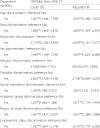Variables selected for analysis
The dependent variable was assessed to evaluate the risk of exposure to SHS by a question, “Are you exposed at work to tobacco smoke from other people?” Respondents answered on a seven-point scale of SHS exposure frequency; the choices were (in terms of all of the working time), “all”, “almost”, “3/4”, “half”, “1/4”, “almost never”, and “never”. For chi-square test, exposure to SHS in workplace was categorized into 3 group; “over 1/4 workhours” (all ~ 1/4), “almost never” and “never”. For logistic regression exposure to SHS in workplace was categorized into 2 group; “over 1/4 workhours” (all ~ 1/4) or “less than 1/4” (almost never and never). The rate of exposure to SHS for more than 1/4 of workhours (ESQ rate) was used to compare the SHS exposure by independent variables.
Independent variables included information on gender (“male” and “female”), age group ( “≤ 39”, “40–49”, “50–59” and “≥ 60”), job status (“self-employed without workers”, “self-employed with workers”, “wage workers (employees)”, “unpaid family worker” and “other workers”), type of wage worker (“permanent workers”, “temporary workers” and “daily workers”), wage provider (“workplace”, “a dispatcher” and “service provider”), Company size as number of workers in workplace ( “≤ 49”, “50–299” and “≥ 300”), type of workplace (“employer's place of business”, “customer's place of business”, “in the case of transportation as cars”, “outdoor (construction, field/etc)”, “my home” and “others”), job category (“manager”, “specialist”, “technician and associate export”, “office worker”, “service worker”, “sales worker”, “experts in agriculture and forestry fishing”, “functional person and related person”, “machine operator and assembly worker”, “laborer” and “soldier”), and night working days in a month ( “≤ 9”, “10–19” and “≥ 20”).
The item designed to evaluate the experience of discrimination at the workplace was used as a variables for the effect of exposure to SHS. The question is “During the past 12 months, did you experience to discrimination at your workplace related to age, race, nationality, gender, religion, disability, sexual orientation, academic group, region of origin, or employment status?” Respondents answered to the question about discrimination with ‘yes' or ‘no'.
The occupational categories of respondents were classified according to the Korean Standard Classification of Occupation (KSCO by National Statistical Office) and classified into occupational groups (52 groups, classification code: 2 digits) and detailed occupation (415 groups, classification code: 4 digits).










 PDF
PDF Citation
Citation Print
Print



 XML Download
XML Download